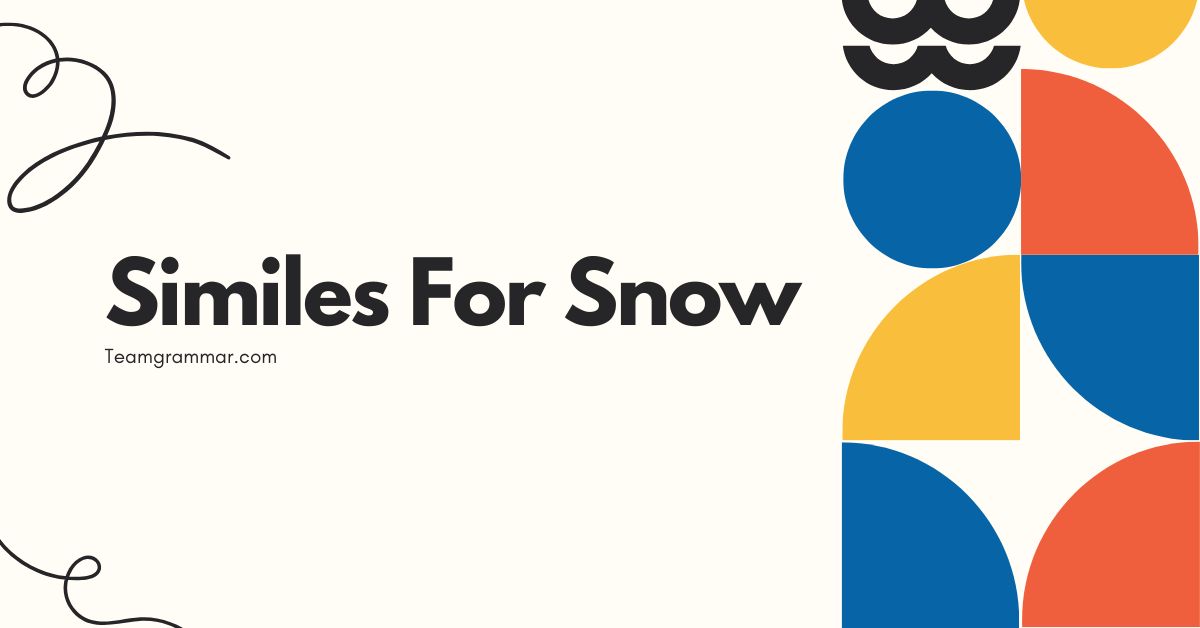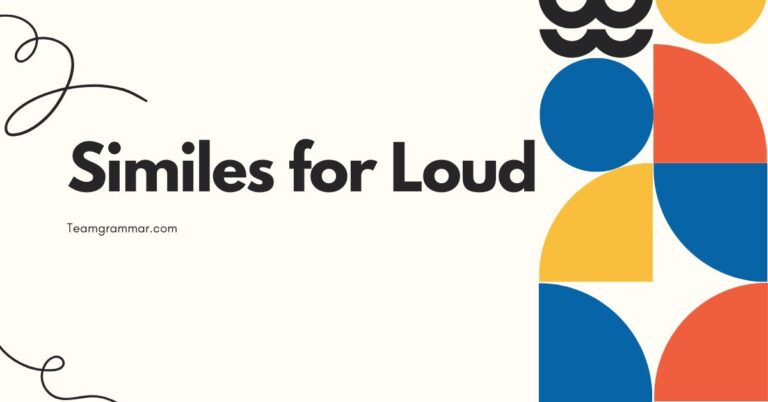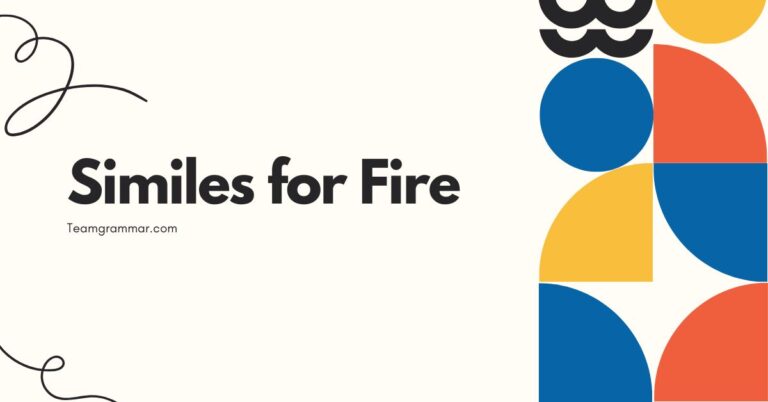47 Similes For Snow: A Grammatical Exploration
Similes are powerful tools in the English language, allowing us to create vivid imagery and enhance our descriptions. Mastering the use of similes, particularly when describing something as evocative as snow, can significantly improve your writing and communication skills.
This article provides a comprehensive guide to understanding and using similes for snow, covering definitions, structures, examples, usage rules, common mistakes, and practice exercises. Whether you’re a student, writer, or language enthusiast, this guide will help you master the art of using similes to paint a picture of a snowy scene.
Table of Contents
- Introduction
- Definition of a Simile
- Structural Breakdown of Similes
- Types of Similes
- Examples of Similes for Snow
- Usage Rules for Similes
- Common Mistakes When Using Similes
- Practice Exercises
- Advanced Topics in Similes
- Frequently Asked Questions
- Conclusion
Definition of a Simile
A simile is a figure of speech that compares two unlike things using the words “like” or “as.” It’s a tool used to create vivid imagery, enhance descriptions, and make writing more engaging. The purpose of a simile is to draw a connection between something familiar and something less so, helping the reader understand or visualize the latter more effectively.
Similes are widely used in literature, poetry, and everyday conversation to add color and depth to language.
In essence, a simile asserts a similarity between two distinct entities, highlighting a shared characteristic or quality. This comparison helps to illuminate a particular aspect of the subject being described, making it more relatable or understandable.
For example, saying “The snow waslikea blanket” compares the snow to a blanket, emphasizing its covering and insulating qualities. This simple comparison can paint a clear picture in the reader’s mind.
Structural Breakdown of Similes
The basic structure of a simile consists of three main components: the subject, the linking word (likeoras), and the object of comparison. The subject is the thing being described, the linking word establishes the comparison, and the object of comparison is what the subject is being compared to.
Understanding this structure is crucial for creating effective and grammatically correct similes.
Here’s a breakdown of the structural elements:
- Subject: The item or concept being described. For example, “the snow.”
- Linking Word: Either “like” or “as.” These words explicitly signal the comparison.
- Object of Comparison: The item or concept the subject is being compared to. For example, “a white sheet.”
A simple example illustrating this structure is: “The snow was like a white sheet.” Here, “the snow” is the subject, “like” is the linking word, and “a white sheet” is the object of comparison.
Types of Similes
While all similes share the same basic structure, they can be categorized based on the aspect of the subject they emphasize. Understanding these categories can help you create more nuanced and effective similes.
Some common types include similes based on appearance, texture, sound, temperature, and movement.
Similes Based on Appearance
These similes focus on the visual characteristics of the snow, such as its color, shape, or brightness. They help the reader visualize the snow more clearly.
Similes Based on Texture
These similes describe how the snow feels to the touch, emphasizing its softness, hardness, or consistency. They engage the reader’s sense of touch.
Similes Based on Sound
These similes focus on the sounds associated with snow, such as the crunching of footsteps or the soft whisper of falling flakes. They appeal to the reader’s sense of hearing.
Similes Based on Temperature
These similes describe the coldness of the snow, often comparing it to other cold objects or sensations. They emphasize the chilling effect of snow.
Similes Based on Movement
These similes focus on how the snow moves, whether it’s falling, drifting, or melting. They create a sense of motion and dynamism.
Examples of Similes for Snow
To illustrate the different types of similes, here are several examples focusing on snow. These examples are categorized by the aspect of snow they emphasize.
Similes Based on Appearance
These similes aim to paint a vivid picture of the snow’s visual characteristics. They often compare its color, shape, or brightness to familiar objects or scenes.
The table below provides 30 examples of similes based on appearance, with detailed explanations to enhance understanding.
| Simile | Explanation |
|---|---|
| The snow was like a blanket of white. | Emphasizes the snow’s covering and pure color. |
| The snow looked as pristine as a freshly laundered sheet. | Highlights the cleanliness and untouched nature of the snow. |
| Snowflakes fell like tiny stars from the sky. | Compares the delicate, star-like shape of snowflakes. |
| The landscape was as white as a polar bear’s fur. | Stresses the intense whiteness of the snowy landscape. |
| The snow sparkled like a million diamonds. | Highlights the reflective quality of snow crystals. |
| The field was as smooth as a canvas of snow. | Emphasizes the even, unbroken surface of the snow-covered field. |
| The snow-covered trees looked like statues draped in white cloth. | Compares the snow-laden trees to sculptures adorned with fabric. |
| The snow was like powdered sugar on the mountains. | Highlights the light, delicate appearance of snow on peaks. |
| It was as if the world were wrapped in a cotton ball of snow. | Emphasizes the soft, all-encompassing nature of the snowfall. |
| The snow shimmered like scattered pearls. | Compares the snow’s subtle shine to the luster of pearls. |
| The snow-covered rooftops looked like frosted cakes. | Highlights the sweet, decorative appearance of snow on buildings. |
| The falling snow was like a curtain of white. | Emphasizes the dense, obscuring effect of heavy snowfall. |
| The snow was as bright as a spotlight. | Stresses the intense reflectivity of the snow. |
| The drifts piled up like dunes in a white desert. | Compares the accumulation of snow to desert landscapes. |
| The snow-covered ground was like a vast, white sea. | Emphasizes the expansive, unbroken surface of the snow. |
| The snowflakes resembled delicate lace falling from the sky. | Highlights the intricate patterns of snowflakes. |
| The snow was as pure as a blank page. | Stresses the untouched, pristine quality of the snow. |
| The landscape transformed into a black and white photograph with the snow. | Highlights the stark contrast created by the snow. |
| The snow on the branches looked like crystallized sugar. | Emphasizes the sweet and delicate appearance of snow-covered branches. |
| The snow was as luminous as a full moon. | Compares the snow’s brightness to the light of the moon. |
| The snow-laden branches looked like sleeping swans. | Highlights the graceful, curved shape of the snow-covered branches. |
| The snow was like a scattering of angel feathers. | Emphasizes the light, ethereal quality of the snow. |
| The frozen lake was as smooth as a mirror under the snow. | Compares the snow-covered lake’s surface to a reflective mirror. |
| The snow-covered hills looked like sleeping giants. | Highlights the massive, imposing appearance of the snow-covered hills. |
| The snow was like a field of glittering confetti. | Emphasizes the sparkling, festive appearance of the snow. |
| The snow-covered trees looked like ghosts in the forest. | Compares the snow-laden trees to spectral figures. |
| The fresh snow was as untrodden as a new world. | Stresses the untouched, pristine quality of the fresh snow. |
| The snow-covered mountains looked like giant wedding cakes. | Highlights the tiered, decorative appearance of the snow-covered mountains. |
| The snow was like a sea of white velvet. | Emphasizes the smooth, luxurious appearance of the snow. |
| The snow-covered garden looked like a scene from a fairy tale. | Compares the snow-covered garden to an enchanting, magical setting. |
Similes Based on Texture
These similes focus on the tactile qualities of snow, describing how it feels to the touch. They often compare its texture to other familiar materials or sensations.
The following table provides 30 examples of similes based on texture, offering a deeper understanding through detailed explanations.
| Simile | Explanation |
|---|---|
| The snow felt like powdered sugar underfoot. | Highlights the fine, soft texture of the snow. |
| The snow was as soft as cotton candy. | Emphasizes the light, fluffy texture of the snow. |
| The packed snow felt like walking on a firm mattress. | Compares the density and slight give of packed snow. |
| The slushy snow felt like a cold, wet sponge. | Highlights the soggy, absorbent texture of slushy snow. |
| The icy snow was as hard as glass. | Emphasizes the solid, unyielding texture of icy snow. |
| The snow was like tiny pellets of ice. | Compares the granular texture of some types of snow. |
| The snow felt as rough as sandpaper on my skin. | Highlights the abrasive texture of wind-blown snow. |
| The snow was as clingy as wet clay. | Emphasizes the sticky quality of melting snow. |
| The crunchy snow sounded like walking on eggshells. | Compares the brittle sound and texture of frozen snow. |
| The snow was as smooth as silk to the touch. | Highlights the delicate, soft texture of freshly fallen snow. |
| The snow felt like walking on a bed of marshmallows. | Emphasizes the soft, yielding texture of deep snow. |
| The snow was as dense as a block of ice. | Compares the compacted texture of old snow. |
| The snow felt like cold, wet sand. | Highlights the grainy, damp texture of melting snow. |
| The snow was as prickly as a cactus on my face. | Emphasizes the sharp, stinging sensation of wind-driven snow. |
| The snow felt like stepping into a freezer. | Compares the intensely cold sensation of deep snow. |
| The snow was as slippery as a skating rink. | Highlights the treacherous, smooth surface of icy snow. |
| The snow felt like sinking into quicksand. | Emphasizes the unstable, engulfing nature of deep, soft snow. |
| The snow was as firm as a freshly made snowball. | Compares the compact, moldable texture of packing snow. |
| The snow felt like tiny needles pricking my skin. | Highlights the sharp, stinging sensation of fine, icy snow. |
| The snow was as heavy as lead when shoveling. | Emphasizes the weight and density of wet snow. |
| The snow felt like walking through glue. | Compares the sticky, resistant texture of melting snow. |
| The snow was as crunchy as a bag of potato chips. | Highlights the crisp, breaking sound and texture of frozen snow. |
| The snow felt like a cold compress on my forehead. | Compares the cooling, soothing sensation of snow. |
| The snow was as gritty as beach sand. | Emphasizes the coarse, abrasive texture of wind-blown snow. |
| The snow felt like walking on broken glass. | Highlights the sharp, cutting sensation of icy snow. |
| The snow was as fluffy as a down pillow. | Compares the light, airy texture of freshly fallen snow. |
| The snow felt like a thin layer of ice covering everything. | Highlights the smooth, slick texture of icy snow. |
| The snow was as compact as a tightly packed snowball. | Emphasizes the dense, firm texture of compressed snow. |
| The snow felt like walking through a dream. | Compares the surreal, soft sensation of deep snow. |
| The snow was as unpredictable as quicksand. | Highlights the unstable, difficult texture of deep, soft snow. |
Similes Based on Sound
These similes focus on the auditory aspects of snow, describing the sounds it makes when it falls, crunches, or melts. They engage the reader’s sense of hearing.
The table below provides 20 examples of similes based on sound, with detailed explanations to enhance understanding.
| Simile | Explanation |
|---|---|
| The snow crunched underfoot like walking on dry leaves. | Compares the sound of snow to the familiar sound of leaves. |
| The falling snow was as silent as a whisper. | Emphasizes the quiet, gentle nature of snowfall. |
| The snow whispered against the windowpane like a secret. | Highlights the soft, subtle sound of snow hitting glass. |
| The snow crunched like broken glass under the car tires. | Compares the sound of compacted snow to shattering glass. |
| The snow fell with the soft hush of a library. | Emphasizes the quiet, peaceful atmosphere created by snowfall. |
| The snow sounded like static on an old radio. | Compares the subtle, hissing sound of wind-blown snow. |
| The snowplow scraped the road like nails on a chalkboard. | Highlights the harsh, grating sound of a snowplow. |
| The meltwater dripped like the ticking of a slow clock. | Compares the steady, rhythmic sound of melting snow. |
| The snow crunched like biting into a crisp apple. | Compares the sharp, clean sound of frozen snow. |
| The avalanche roared like a freight train. | Emphasizes the loud, powerful sound of an avalanche. |
| The snow fell so softly it was like listening to silence. | Highlights the absence of sound during gentle snowfall. |
| The wind howled through the snowy trees like a banshee. | Compares the eerie, wailing sound of wind in the snow. |
| The snow settling on the branches sounded like a gentle sigh. | Emphasizes the soft, quiet sound of snow accumulating. |
| The snow-covered ground muffled sounds like a thick blanket. | Compares the sound-dampening effect of snow to a blanket. |
| The ice cracking on the lake sounded like distant thunder. | Highlights the loud, booming sound of ice breaking. |
| The snowball fight sounded like a flurry of soft punches. | Compares the muffled thuds of snowballs hitting. |
| The snow melting in the sun sounded like a gentle rain. | Emphasizes the light, trickling sound of melting snow. |
| The crunch of snow under boots was as satisfying as bubble wrap popping. | Highlights the pleasing, crisp sound of walking on snow. |
| The snow falling on the tin roof sounded like a thousand tiny drums. | Compares the rhythmic sound of snow on metal roofing. |
| The snow blowing against the house sounded like a restless spirit. | Emphasizes the eerie, unsettling sound of wind-blown snow. |
Similes Based on Temperature
These similes focus on the coldness associated with snow, often comparing it to other cold objects or sensations. They emphasize the chilling effect of snow.
The table below provides 20 examples of similes based on temperature, with detailed explanations to enhance understanding.
| Simile | Explanation |
|---|---|
| The snow was as cold as ice. | Emphasizes the intense coldness of snow. |
| The air felt as frigid as a walk-in freezer. | Compares the cold air to a very cold appliance. |
| The snow-covered ground felt like stepping into a deep freeze. | Highlights the sudden chill of contact with snow. |
| The wind cut through me like a blade of ice. | Emphasizes the sharp, penetrating cold of the wind. |
| The snow was like a cold compress on my face. | Compares the cooling sensation of snow. |
| The air was as biting as a winter wind in Siberia. | Highlights the extreme coldness of the air. |
| The snow felt as bitter as a frozen tear. | Compares the coldness to a feeling of emotional coldness. |
| The snow was as chilling as a ghost’s touch. | Emphasizes the unnerving coldness of the snow. |
| The cold seeped into my bones like icy water. | Compares the penetrating cold to water. |
| The snow was as frosty as an old windowpane. | Highlights the icy, cold surface of the snow. |
| The air stung my lungs like a mouthful of ice. | Compares the cold air to the sensation of eating ice. |
| The snow felt as harsh as a winter wasteland. | Highlights the bleak, cold environment created by snow. |
| The cold was as sharp as a shard of glass. | Emphasizes the piercing coldness of the snow. |
| The snow felt like stepping into a forgotten tomb. | Compares the coldness to a place of death and decay. |
| The cold was as relentless as a frozen winter night. | Highlights the unyielding coldness of the night. |
| The snow was as crisp as the first frost of winter. | Compares the coldness to the first frost. |
| The cold bit at my cheeks like a hungry wolf. | Emphasizes the aggressive, biting coldness. |
| The snow felt as unyielding as a block of granite. | Compares the coldness to a hard, unyielding stone. |
| The air was as desolate as a frozen tundra. | Highlights the bleak, cold landscape. |
| The snow was as unforgiving as a frozen heart. | Compares the coldness to a lack of emotion. |
Similes Based on Movement
These similes focus on how the snow moves, whether it’s falling, drifting, or melting. They create a sense of motion and dynamism.
The table below provides 20 examples of similes based on movement, with detailed explanations to enhance understanding.
| Simile | Explanation |
|---|---|
| The snow fell like a gentle curtain descending. | Emphasizes the smooth, graceful descent of snow. |
| The wind whipped the snow around like a dervish dancing. | Compares the swirling motion of snow to a spinning dancer. |
| The snow drifted across the field like a slow-moving river. | Highlights the gradual, flowing movement of snow. |
| The snowflakes danced in the air like tiny ballerinas. | Compares the delicate, twirling motion of snowflakes to dancers. |
| The snow melted like tears on a warm cheek. | Emphasizes the slow, dissolving motion of melting snow. |
| The snow swirled around the streetlights like moths to a flame. | Compares the circling motion of snow to insects around light. |
| The snow fell in clumps like feathers falling from a ripped pillow. | Highlights the irregular, clumped descent of snow. |
| The snow cascaded down the mountain like a waterfall of white. | Compares the flowing motion of snow to a waterfall. |
| The snow blew across the plains like a herd of wild horses. | Emphasizes the rapid, sweeping movement of snow. |
| The snowflakes twirled like acrobats in the winter sky. | Compares the playful, spinning motion of snowflakes to performers. |
| The snow fell steadily like a metronome keeping time. | Highlights the consistent, rhythmic descent of snow. |
| The snow drifted and piled up like waves on a frozen ocean. | Compares the accumulating motion of snow to ocean waves. |
| The snow seemed to chase the wind like a playful dog. | Emphasizes the erratic, chasing movement of snow. |
| The snow melted away like a dream fading at dawn. | Compares the disappearing motion of snow to a fading dream. |
| The snow swirled and eddied like currents in a frozen river. | Highlights the complex, swirling motion of snow. |
| The snow fell silently like a secret whispered from the sky. | Emphasizes the quiet, gentle descent of snow. |
| The snow piled up against the door like a barricade forming. | Compares the accumulating motion of snow to a barrier. |
| The snow danced on the wind like a kite without a string. | Highlights the free, uncontrolled movement of snow. |
| The snow swept through the valley like a ghostly apparition. | Compares the swift, ethereal movement of snow. |
| The snow vanished in the sun like a fleeting memory. | Emphasizes the quick, disappearing motion of melting snow. |
Usage Rules for Similes
Using similes effectively requires adherence to certain grammatical and stylistic rules. The most important rule is to ensure that the comparison is logical and meaningful.
The two things being compared should share a relevant characteristic that the simile aims to highlight. Avoid comparisons that are strained or nonsensical, as they can confuse the reader.
Another important rule is to use similes sparingly. Overusing similes can make your writing sound repetitive and contrived.
Use them strategically to enhance your descriptions and add impact to your writing. Consider the context and audience when choosing your similes.
A simile that works well in one situation may not be appropriate in another.
Finally, ensure that your similes are grammatically correct. The linking words “like” and “as” should be used correctly to establish the comparison.
The subject and object of comparison should be parallel in structure. For example, avoid comparing a noun to a verb or an adjective to an adverb.
Common Mistakes When Using Similes
One common mistake is confusing similes with metaphors. While both are figures of speech that compare two unlike things, similes use “like” or “as” to make an explicit comparison, while metaphors imply the comparison without using these words.
For example, “The snow was like a blanket” is a simile, while “The snow was a blanket” is a metaphor.
Another common mistake is using clichés or overused similes. These similes have lost their impact and can make your writing sound unoriginal.
Try to come up with fresh, creative comparisons that will engage your readers. For example, instead of saying “The snow was as white as snow,” try “The snow was as white as freshly laundered linen.”
Finally, avoid using mixed metaphors or similes, where the comparison is inconsistent or illogical. For example, “The snow was like a blanket, covering the landscape with a sea of white” mixes the image of a blanket with that of a sea, creating a confusing and disjointed image.
Here are some examples of common mistakes and their corrections:
| Incorrect | Correct | Explanation |
|---|---|---|
| The snow was like. | The snow was like cotton. | The simile is incomplete. |
| The snow was as white. | The snow was as white as a dove. | The simile is incomplete. |
| The snow was a blanket. | The snow was like a blanket. | This is a metaphor, not a simile. |
| The snow was like walking. | The snow was like walking on clouds. | Incorrect comparison. |
Practice Exercises
Here are some practice exercises to help you master the use of similes for snow. Each exercise focuses on a different aspect of simile construction and usage.
Exercise 1: Identifying Similes
Identify the similes in the following sentences:
- The snow fell like feathers from the sky.
- The wind howled through the trees.
- The snow was as cold as ice.
- The city was a ghost town.
- The snow sparkled like diamonds.
- The snow was a white blanket over the town.
- The snow crunched underfoot like walking on eggshells.
- The snow was as silent as a sleeping child.
- Her smile was the sun after the storm.
- The snow glittered like a million stars.
Answers:
- like feathers from the sky
- (No simile)
- as cold as ice
- (No simile)
- like diamonds
- (No simile)
- like walking on eggshells
- as silent as a sleeping child
- (No simile)
- like a million stars
Exercise 2: Completing Similes
Complete the following similes with an appropriate comparison:
- The snow was as white as ______.
- The snow fell like ______.
- The snow was as cold as ______.
- The snow sparkled like ______.
- The snow crunched underfoot like ______.
- The snow was as silent as ______.
- The snow drifted like ______.
- The snow felt like ______.
- The icy wind was as sharp as ______.
- The snow looked like ______.
Possible Answers:
- a dove
- tears
- a witch’s heart
- a thousand candles
- firewood crackling
- the grave
- a ghost
- a thousand needles
- broken glass
- a dream
Exercise 3: Writing Similes
Write your own similes to describe the following aspects of snow:
- The appearance of freshly fallen snow
- The sound of wind blowing through snow-covered trees
- The feeling of snow on your face
- The way snow changes the landscape
- The experience of walking in deep snow
- The appearance of snowflakes
- The feeling of shoveling snow
- The sound of an avalanche
- The way snow reflects light
- The movement of snow in a blizzard
Possible Answers:
- The appearance of freshly fallen snow: “The snow was as pristine as a freshly laundered sheet.”
- The sound of wind blowing through snow-covered trees: “The wind howled through the snowy trees like a banshee.”
- The feeling of snow on your face: “The snow felt like tiny needles pricking my skin.”
- The way snow changes the landscape: “The landscape transformed into a black and white photograph with the snow.”
- The experience of walking in deep snow: “The snow felt like sinking into quicksand.”
- The appearance of snowflakes: “The snowflakes resembled delicate lace falling from the sky.”
- The feeling of shoveling snow: “The snow was as heavy as lead when shoveling.”
- The sound of an avalanche: “The avalanche roared like a freight train.”
- The way snow reflects light: “The snow was as luminous as a full moon.”
- The movement of snow in a blizzard: “The snow swept through the valley like a ghostly apparition.”
Advanced Topics in Similes
For advanced learners, exploring more complex aspects of similes can enhance their writing and analytical skills. One advanced topic is the use of extended similes, where the comparison is developed over several sentences or paragraphs.
This allows for a more detailed and nuanced exploration of the similarities between the subject and object of comparison.
Another advanced topic is the use of similes in different genres and styles of writing. Similes can be used in poetry, fiction, essays, and even technical writing, but the way they are used may vary depending on the context.
Analyzing how similes are used in different types of writing can provide valuable insights into their effectiveness and impact.
Finally, advanced learners can explore the cultural and historical context of similes. Similes often reflect the values, beliefs, and experiences of a particular culture or time period.
Studying the similes used in different cultures and historical periods can provide a deeper understanding of their significance and meaning.
Frequently Asked Questions
- What is the difference between a simile and a metaphor?
- How can I make my similes more creative?
- Is it okay to use similes in formal writing?
- How many similes should I use in a piece of writing?
- Can a simile be too complex?
A simile is a comparison using “like” or “as,” while a metaphor implies a comparison without using these words. A simile states that something is like something else, while a metaphor states that something is something else.
To make your similes more creative, avoid clichés and overused comparisons. Try to think of fresh, original ways to describe the subject.
Consider using unexpected or
unexpected or unconventional objects of comparison.
Yes, similes can be used in formal writing, but they should be used sparingly and with careful consideration of the audience and context. Avoid using overly informal or colloquial similes in formal writing.
There is no fixed rule for how many similes to use, but it’s generally best to use them judiciously. Overusing similes can make your writing sound contrived or repetitive.
Use them strategically to enhance your descriptions and add impact to your writing.
Yes, a simile can be too complex if it is difficult for the reader to understand or if it distracts from the main point of the writing. The best similes are clear, concise, and relevant to the subject being described.
Conclusion
Similes are a valuable tool for enhancing your writing and communication skills. By understanding the definition, structure, types, and usage rules of similes, you can create vivid imagery and add depth to your descriptions.
Mastering the use of similes for snow, in particular, can help you capture the beauty and complexity of snowy scenes in your writing. Remember to use similes strategically, avoid common mistakes, and practice regularly to improve your skills.
With dedication and practice, you can master the art of using similes to paint a picture with words.







